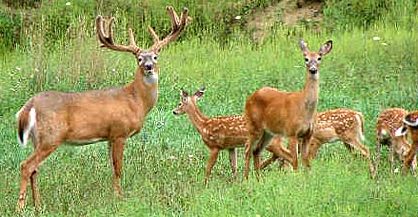Changes in people and hunting culture in addition to other factors have led to a substantially increase in white-tailed deer management over the past few decades. More than ever, hunters and landowners are looking to get the most out of their property or deer lease. When it comes to managing deer there are three components that must be addressed: age, genetics and nutrition. Of these three, age structure is arguably the most important factor in a deer herd.
Why? Well most hunters are interested in management because they want to see and harvest big bucks. They want better deer hunting. Bucks don’t get big unless they are mature, and it takes experienced does to add deer to the population. Mature bucks and does maintain a dominance hierarchy, where the do proportionally more breeding, although all age classes of bucks participate. Age is important in does, too. Mature does seek out the best habitat, providing better fawn production and increased fawn survival.

Sound familiar? In many places, 1 1/2 (yearling) and 2 1/2 year old bucks make up the bulk of the harvest each year. The simple fact of the matter is that there will not be any mature bucks on properties if harvest management is not implemented. If you want big bucks on the menu, then realize that maximum antler length and weight, which go hand-in-hand, are not reached until bucks are at least 5 1/2 years old. It can be very difficult to “pass” on a buck because of concern over whether or not a hunter on a neighboring property will shoot it, but think about it this way. If you shoot an immature buck just so someone else does not, then you in fact are that neighbor your worried about.
Although many properties are not big enough to contain home ranges of several bucks, a successful deer management program is possible if a deer management cooperative is formed by talking to neighboring landowners. If it’s not worth the trouble, then I’d have to question how committed you are to really improving the quality of the deer found on your property. Like some guy smarter than me said, “If you do what you have always done, then you will get what you always got.” It other words, it takes change to create change. Focus management on increasing the age of deer, especially bucks, on your property.
Nutrition is also important. This varies a lot from property to property and ultimately influences body size, antler size, reproductive success and fawn survival. It can also impact the timing of the rut. Hunters must understand that body growth, maintenance and survival of an individual deer takes precedence over antler growth, fawn production and lactation. A buck that is struggling to find food will not grow antlers that reach his genetic potential. Similarly, does that are in poor body condition will fail to either produce or raise fawns successfully. Bucks and does must survive before they can thrive.
If you think food is not important, then can you make a list of foods deer eat? Studies have shown survival of fawns from malnourished does can be less than 10 percent, but fawn survival from healthy, well-fed does can exceed 85 percent. Poor nourishment can also lead to other reproductive consequences that I will not mention here, but they are not good a deer management program… at least not a successful one.
Providing adequate nutrition to deer on your property means providing an adequate amount of food per deer. This often requires maintaining the population in balance with the available habitat. Feeding protein pellets or developing food plots can help, but this keeping deer well-nourished often requires shooting does. Some hunters still do not believe it, but this is “old school” thinking. This line of thinking started when deer numbers were low and populations were being established.
When deer populations exceed the habitat’s carrying capacity, other wildlife species suffer as well. Overabundant deer can decimate the forest understory, which negatively affects the food, cover and structural requirements of other species, including wild turkeys. In addition to providing supplemental foods, other habitat management practices that can improve the quantity and quality of forage available to deer forest thinning, prescribed burning, brush control and planting trees and shrubs that bear soft and hard mast.
Genetics, although something to consider, are not as important when it comes to deer management. Manipulating harvest will work, but the results will take much, much longer than simply increasing the age and nutrition of deer on your property. Factors influencing genetic quality are complex. It is important to realize genetic traits are determined and passed on by both bucks and does. Antler characteristics, as well as other physical traits, are genetically based but environmentally influenced.
In closing, the genetic potential of any deer herd can never be expressed until adequate nutrition is available and the animals are able to reach maturity within a sound social structure. Age, genetics and nutrition are important. Age is the most important factor when it comes to having mature deer, but providing adequate nutrition through proper antlerless harvest, habitat enhancement practices and providing supplemental foods will ensure the management program on your property works and the deer hunting improves. If the property you own or hunt is small, then contacting the neighboring landowners/hunters will be necessary for your program to be successful.